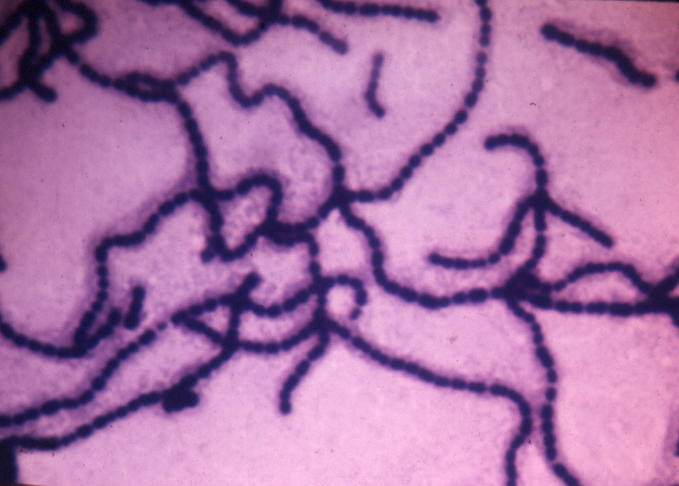Streptococci. Sounds like an impressive word.
Most people recognize it by it's layman term of the disease of which it is associated in equines: strangles.
Most people recognize it by it's layman term of the disease of which it is associated in equines: strangles.
But what about it? Many of us have seen horses with strangles and know the ideas behind quarantining new horses, bastard strangles, the debate on the vaccines...
But let's talk about the bacteria itself. Why not learn more about the basics and then sound really clever when talking with other horsefolks?
First, it's a bacteria. This is cool because it means that it can be susceptible to antibiotics.
I think it's kind of a cool bacteria because it forms chains or these cute little pairs. It is a gram positive bacteria, so it takes up crystal violet, that purple stain that many people remember from their biology lab days...
 | ||
| Positively adorable |
That purple dye is taken up by the thick peptidoglycan layer of the cell wall. This layer helps hold the cell together, so to speak. This link has an awesome way of explaining it and its function.
So, awesome. It's gram positive, likes to hang out in chains, and now what.
Different antibiotics target different elements of bacteria. Some antibiotics are bacteriocidal, as in they actively kill targeted bacteria. Sounds great, but sometimes killing too many bacteria at once is a negative. Some antibiotics are bacteriostatic, where they just prevent the bacteria from replicated. A little slower way to go about things, but good to help prevent shock from overwhelming the immune system with dead bacteria. Some antibiotics work better on gram positive bacteria; other are more successful on gram negative.
Different antibiotics target different elements of bacteria. Some antibiotics are bacteriocidal, as in they actively kill targeted bacteria. Sounds great, but sometimes killing too many bacteria at once is a negative. Some antibiotics are bacteriostatic, where they just prevent the bacteria from replicated. A little slower way to go about things, but good to help prevent shock from overwhelming the immune system with dead bacteria. Some antibiotics work better on gram positive bacteria; other are more successful on gram negative.
So let's say we are looking at this Streptococcus and all it's gram positive glory with its peptidoglycan layer. Perhaps we should look at a way to interfere with this protective shielding.
This of course is the basis of an antibiotic which is very commonly (and excessively) used: Penicillin.
This of course is the basis of an antibiotic which is very commonly (and excessively) used: Penicillin.
Penicillin binds to an enzyme used by the bacteria to try and rebuild/regrow their cell wall. They cannot successfully do so and subsequently, the cell wall is shed and the bacteria will die.
Not to evolve this into the treatment of Strangles, but typically, healthy horses do fine without jumping the gun and running for antibiotics.
Interestingly, I was reading a study talking about trimethoprim-sulfadiazine (SMZ), where it did not indicate one way or another that it efficiently or effectively worked against S. equi spp equi. Just food for thought.
But in case someone wanted to know a little more about the bug behind the Strangles name, here you go. There's obviously a lot of literature and a lifetime could be spent thinking about it, but I think it's worthwhile learning a little bit more about common bacteria, viruses, antibiotics, and vaccines used in the equine world.
Then again I'm wearing a shirt that says "I heart Nerds" so that pretty much defines my position.
An investment in knowledge pays the best interest.
Benjamin Franklin
Read more at http://www.brainyquote.com/quotes/topics/topic_education.html#IF8uZEjuyDwuk6tL.99
Benjamin Franklin
Read more at http://www.brainyquote.com/quotes/topics/topic_education.html#IF8uZEjuyDwuk6tL.99

True story, I got vaccinated for strangles once on accident :)
ReplyDeleteI believe it! Intranasal or IM form?
DeleteOne vet I was working with accidentally missed the dog and hit me with the needle. Good thing she didn't depress the syringe. It was phenobarbitol. Oops.